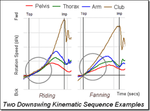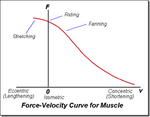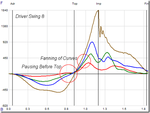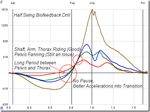WILDTHING
Well-known member
- Joined
- Sep 16, 2018
- Messages
- 893
- Reaction score
- 360
- Handicap
- 15
- Thread starter
- #26
Golf instruction on 'How' is an art while the biomechanics 'stuff' is a 'What'. Biomechanics in itself might be able to determine the differences in the kinematics/kinetics between pros and recreational golfers but it cannot teach a recreational golfer how to swing like a pro.
If a golf instructor has done his job properly , he would assess your capabilities and then decide what might work best for you although there is a risk he could be leading you down a crooked path.
If I was offered a golf lesson and the instructor said I need to teach you 'stack and tilt' , I think I have enough knowledge to decide not to use him . Not because I don't think its a valid swing technique (it is) but I know it will cause my specific body damage .
Further , if the golf instructor was going to teach me a technique to actively use my wrists in the downswing , I'd probably decline. Or if the golf instructor said he was going to teach me a body swing with passive arms , I'd probably go elsewhere.
I know I cannot swing like a Tour pro and I'll probably end up with an arm swing (with a reactive pivot) than a pivot driven one (ie. with dynamic x-factors built in). When I say reactive pivot , I don't mean that it doesn't follow the kinematic sequence. It will still be Pelvis/Ribcage/Arm/Club but there won't be some stretch-shorten x-factor between my pelvis & torso or torso & shoulder girdle. I'll probably be using only my shoulder girdle muscles to create clubhead speed (with some x-factor between the shoulder girdle and wrists) in the early downswing before release and some ground reaction forces to get my body out of the way of my swinging arms.
If a golf instructor has done his job properly , he would assess your capabilities and then decide what might work best for you although there is a risk he could be leading you down a crooked path.
If I was offered a golf lesson and the instructor said I need to teach you 'stack and tilt' , I think I have enough knowledge to decide not to use him . Not because I don't think its a valid swing technique (it is) but I know it will cause my specific body damage .
Further , if the golf instructor was going to teach me a technique to actively use my wrists in the downswing , I'd probably decline. Or if the golf instructor said he was going to teach me a body swing with passive arms , I'd probably go elsewhere.
I know I cannot swing like a Tour pro and I'll probably end up with an arm swing (with a reactive pivot) than a pivot driven one (ie. with dynamic x-factors built in). When I say reactive pivot , I don't mean that it doesn't follow the kinematic sequence. It will still be Pelvis/Ribcage/Arm/Club but there won't be some stretch-shorten x-factor between my pelvis & torso or torso & shoulder girdle. I'll probably be using only my shoulder girdle muscles to create clubhead speed (with some x-factor between the shoulder girdle and wrists) in the early downswing before release and some ground reaction forces to get my body out of the way of my swinging arms.


















